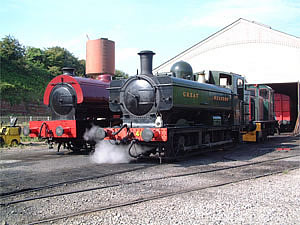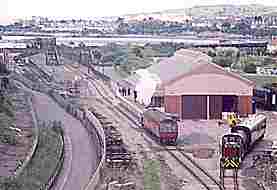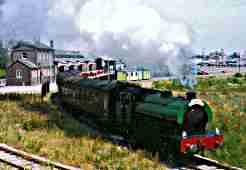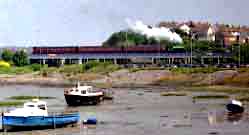The Vale of Glamorgan Railway Company
The History of the Railway
The VoGRC was formed in 1977 as the Butetown Historical Railway Society (BHRS) which was based in the historic Taff Vale Railway (TVR) station of Bute Road (now Cardiff Bay) in Cardiff. It was from near this site that the very first train in South Wales ran in October 1840, when the TVR opened the line to Abercynon, extending to Merthyr Tydfil - then the largest town in South Wales - in April 1841.
 The station was at the heart of the coal export trade which saw countless millions of tons of best steam coal shipped to the seafaring nations of the world. Around 1870, the TVR set up its Bute Road headquarters in what had been the Spanish consulate, and it was this almost-derelict building which the BHRS acquired in 1977. Over the years, society members refurbished the building and landscaped the surrounding area to establish its railway centre, with the intention of operating steam trains along the Bute Road branch and on to tourist
attractions on the British Rail network in South Wales.
The station was at the heart of the coal export trade which saw countless millions of tons of best steam coal shipped to the seafaring nations of the world. Around 1870, the TVR set up its Bute Road headquarters in what had been the Spanish consulate, and it was this almost-derelict building which the BHRS acquired in 1977. Over the years, society members refurbished the building and landscaped the surrounding area to establish its railway centre, with the intention of operating steam trains along the Bute Road branch and on to tourist
attractions on the British Rail network in South Wales.
A highspot came in 1988 with the arrival on site of ten locomotives from Woodham Brothers' scrapyard at Barry. The locomotives were intended as the centre-pieces of a Wales Steam Heritage Centre which would be established at Bute Road. However, it soon became apparent that the BHRS proposals were in conflict with those of the Cardiff Bay Development Corporation which had been set up to transform the derelict former dockland area into a vibrant housing, leisure and light-industrial complex worthy of the capital city of Wales.
Relocation became a priority, and eventually agreement was reached with the Vale of Glamorgan Borough Council to move the Society's base to Barry Island, where its dream of a rail heritage centre could be realised. The centre was formally launched in June 1994, at which time the society also announced its change of name to the Vale of Glamorgan Railway Company (VoGRC). Work started on the heritage centre in February 1996, and all the locos and rolling stock were transferred from Bute Road to Barry Island on the 6th and 7th of February the following year.
The Railway Today

In the overview of the Heritage Centre, seen on the first day of operation with Sir Gomer in action, the Goods shed is served by two roads, while the storage sidings are seen to the right. The train is seen heading into the goods shed platform, which was first used by Santa Specials in December 1998. Since then, the track was extended into the Valley Lines' platform (upper left) in time for the 1999 Santa Special programme, and laid across the causeway (glimpsed above and to the right of the main shed) to Hood Road Goods Shed.
The station building on Platform One celebrated its centenary on 3rd August 1996, and has since undergone a high standard of refurbishment to become a display centre with ticket office, shop and refreshment room.
 At the end of the platform used to stand Barry Island Signal Box, which was dismantled over the weekend of March 21/22 1998, and placed into storage pending re-erection on the end of the island platform where it will eventually control trains on and off the heritage site. Now the track along the causeway is open to the goods shed at Hood Road, where the VoGRC will establish its main works and restoration site.
At the end of the platform used to stand Barry Island Signal Box, which was dismantled over the weekend of March 21/22 1998, and placed into storage pending re-erection on the end of the island platform where it will eventually control trains on and off the heritage site. Now the track along the causeway is open to the goods shed at Hood Road, where the VoGRC will establish its main works and restoration site.
A temporary platform has been built at Hood Road (pictured left as Pamela leaves with one of the first trains to use the platform on June 23 2001) where visitors can detrain to stroll around the Waterfront development or look around the shops in the main shopping thoroughfare a short walk away. Eventually it will be replaced by Woodham Halt, named in honour of Dai Woodham, the Barry scrap metal merchant who played such an important part in the UK rail preservation movement.
Barry Tunnel closed in 1971 and is currently used by a shooting club, but the long-term hope is to reclaim it for the heritage centre to run trains through it to the Pier Head. It is hoped that steamers operating in the Bristol Channel will once more visit Barry, giving the opportunity for combined steam trips by train and boat to other coastal resorts along the Bristol Channel and Severnside.
 Five years after moving to Barry Island, March 11 2001 was a milestone in the VoGRC's plans to establish a railway heritage centre, when the first train made
several passes along the causeway from Barry Island to the site of Woodham Halt at Hood Road.
Five years after moving to Barry Island, March 11 2001 was a milestone in the VoGRC's plans to establish a railway heritage centre, when the first train made
several passes along the causeway from Barry Island to the site of Woodham Halt at Hood Road.